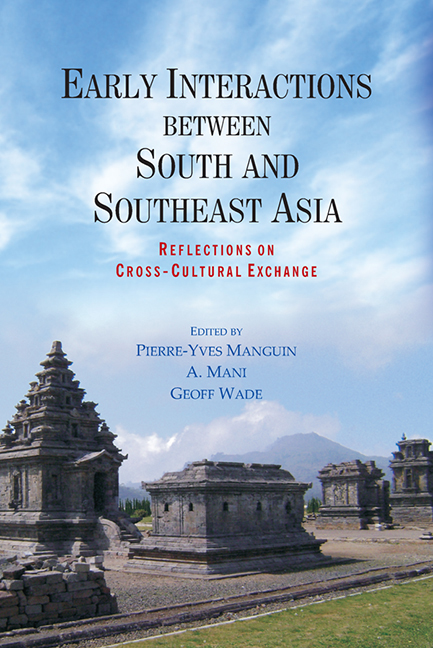Book contents
- Frontmatter
- Contents
- FOREWORD
- Preface
- Introduction
- PART I New Archaeological Evidence from South Asia and Southeast Asia
- 1 Central Vietnam during the Period from 500 BCE to CE 500
- 2 Ban Don Ta Phet and Khao Sam Kaeo: The Earliest Indian Contacts Re-assessed
- 3 Preliminary Study of Indian and Indian Style Wares from Khao Sam Kaeo (Chumphon, Peninsular Thailand), Fourth-Second Centuries BCE
- 4 Early Contacts between India and the Andaman Coast in Thailand from the Second Century BCE to Eleventh Century CE
- 5 The Batujaya Site: New Evidence of Early Indian Infl uence in West Java
- 6 Continuity and Change in South Indian Involvement in Northern Sumatra: The Inferences of Archaeological Evidence from Kota Cina and Lamreh
- 7 South Asia and the Tapanuli Area (North-West Sumatra): Ninth-Fourteenth Centuries CE
- 8 Emergence of Early Historic Trade in Peninsular India
- 9 Contacts between India and Southeast Asia in Ceramic and Boat Building Traditions
- 10 Marine Archaeological Investigations along the Tamil Nadu Coast and their Implications for Understanding Cultural Expansion to Southeast Asian Countries
- PART II Localisation in Southeast Asia
- LIST OF CONTRIBUTORS
- INDEX
5 - The Batujaya Site: New Evidence of Early Indian Infl uence in West Java
from PART I - New Archaeological Evidence from South Asia and Southeast Asia
Published online by Cambridge University Press: 21 October 2015
- Frontmatter
- Contents
- FOREWORD
- Preface
- Introduction
- PART I New Archaeological Evidence from South Asia and Southeast Asia
- 1 Central Vietnam during the Period from 500 BCE to CE 500
- 2 Ban Don Ta Phet and Khao Sam Kaeo: The Earliest Indian Contacts Re-assessed
- 3 Preliminary Study of Indian and Indian Style Wares from Khao Sam Kaeo (Chumphon, Peninsular Thailand), Fourth-Second Centuries BCE
- 4 Early Contacts between India and the Andaman Coast in Thailand from the Second Century BCE to Eleventh Century CE
- 5 The Batujaya Site: New Evidence of Early Indian Infl uence in West Java
- 6 Continuity and Change in South Indian Involvement in Northern Sumatra: The Inferences of Archaeological Evidence from Kota Cina and Lamreh
- 7 South Asia and the Tapanuli Area (North-West Sumatra): Ninth-Fourteenth Centuries CE
- 8 Emergence of Early Historic Trade in Peninsular India
- 9 Contacts between India and Southeast Asia in Ceramic and Boat Building Traditions
- 10 Marine Archaeological Investigations along the Tamil Nadu Coast and their Implications for Understanding Cultural Expansion to Southeast Asian Countries
- PART II Localisation in Southeast Asia
- LIST OF CONTRIBUTORS
- INDEX
Summary
INTRODUCTION
West Java has always been known as an area with very sparse archaeological remains from the Hindu-Buddhist period, if compared to Central and East Java, although written sources – both inscriptions and manuscripts – state that in West Java there were once two kingdoms, known as Tarumanagara and Sunda. The Tarumanagara polity, known from the famous group of seven Sanskrit inscriptions dated paleographically to the fifth century CE appears to have still been in existence in the 660s, when two embassies were sent to China by a country named To Lo Mo (Duolomo) in Chinese sources. The fifth-century stone inscriptions repeatedly refer to the City of Taruma (Tarumanagara), to King Purnavarman, and to gods Vishnu and Indra.
After the seventh century, little is known about events in West Java, until a polity named Sunda is mentioned in the inscription of Rakyan Juru Pangambat (CE 932); it is written in Old Malay and refers to a king of Sunda ‘regaining his power’. There is therefore a distinct possibility, evoked long ago by Coedès and reasserted by Indonesian historians, that we have, in between the demise of Tarumanagara and the rise of Sunda, a period of domination by Srivijaya (if the CE 686 inscription of Kota Kapur mentioning a Malay expedition to bhumi Jawa is to be understood as referring to West Java, which is so far not proved). This kingdom of Sunda survived until the sixteenth century, when it succumbed to the newly dominant Islamic political powers.
The discovery in West Java in the 1980s of the large temple complex of Batujaya brought a considerable amount of new data to document the history of the first millennium CE in West Java, though it does not necessarily bring answers to the above historical questions (Fig. 5.1). The site is now in the middle of a large scale restoration programme and many research projects were carried out on and around the temples. The site is situated some 2 km away from the present-day course of the Tarum River (Citarum), but appears to have been traversed by a now extinct branch of this same river flowing north into the sea, now 4 km away.
- Type
- Chapter
- Information
- Early Interactions between South and Southeast AsiaReflections on Cross-Cultural Exchange, pp. 113 - 136Publisher: ISEAS–Yusof Ishak InstitutePrint publication year: 2011



